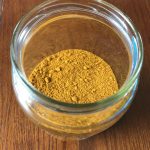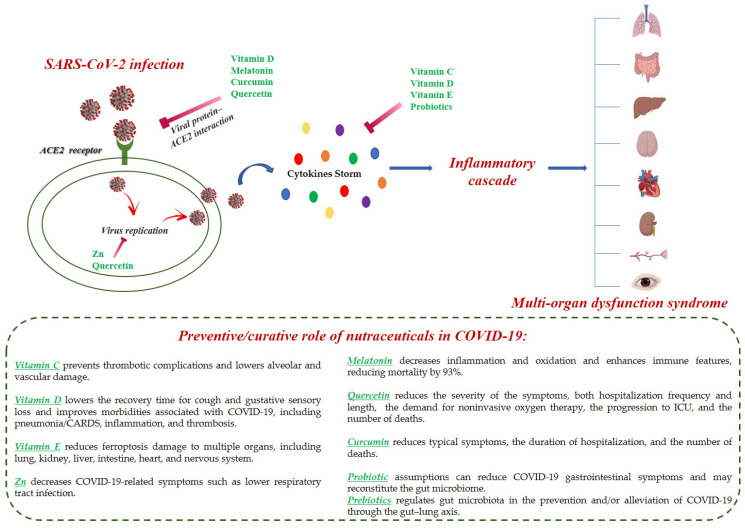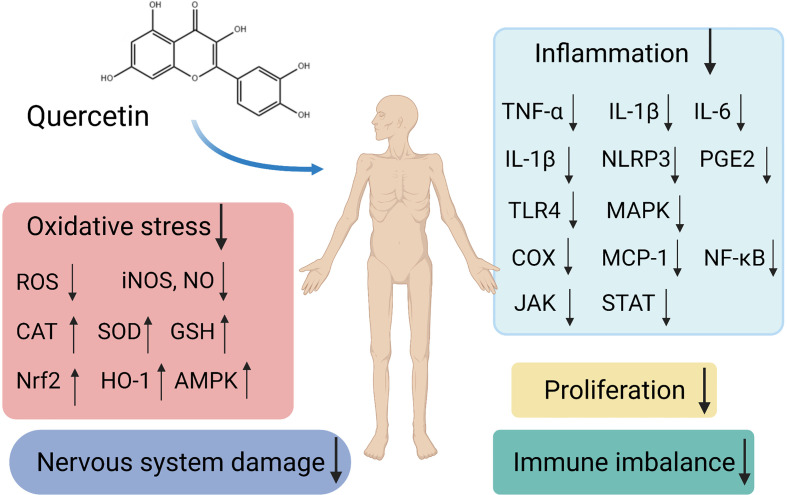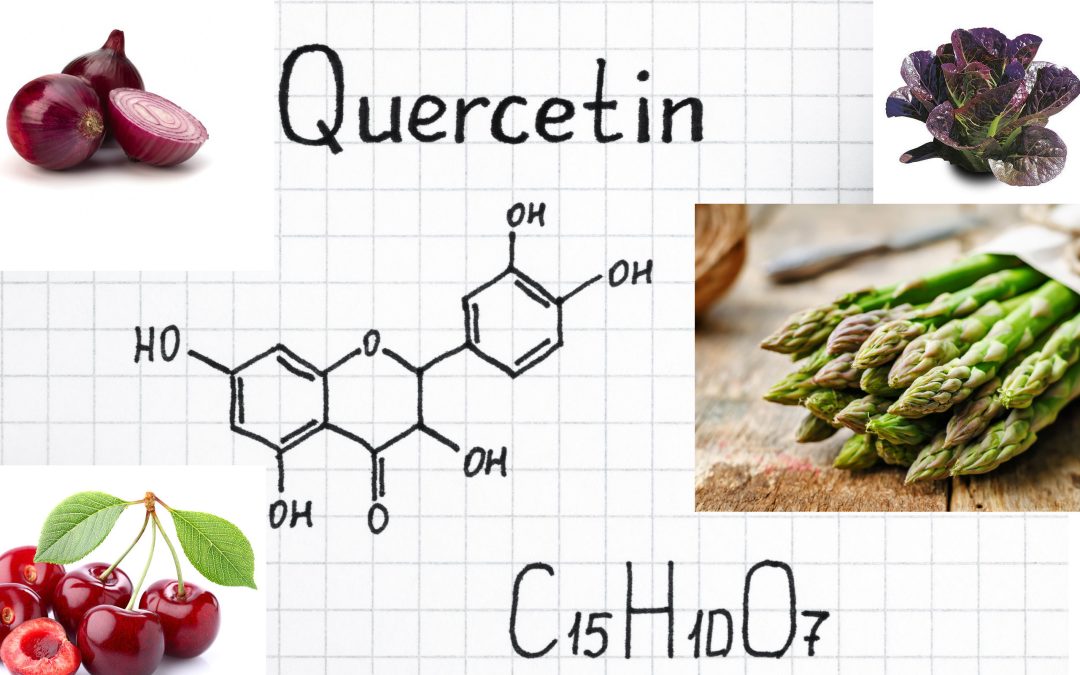Quercetin is known to be used in the treatment of cancer, allergic reactions, inflammation, arthritis and cardiovascular disorders. It also plays an important role in platelet aggregation and lipid peroxidation and enhances the biogenesis of mitochondria. Discover here all the quercetin properties!
Quercetin properties: the molecule and its physical and chemical properties
Quercetin (3,3,4,5,7-pentahydroxyflavone), is one of the secondary metabolites widely present in the Plant kingdom. The flavonoid quercetin is a polyphenol composed of three benzene rings and five hydroxyl groups.
Quercetin was first isolated and recognized by Szent-Gyorgyi in the year 1936. The chemical formula of quercetin is C15H10O7. The structure has a flavonic nucleus made up of two benzene rings and is connected by a heterocyclic pyronic ring; it is an aglycone. This flavonoid is known to possess antioxidant properties and to have a protective function against aging. Although it is an aglycone and does not include carbohydrate portions, it is nevertheless available in nature in both free and conjugated states: for example, it is found in the form of a glycoside in food. After ingestion, the glycoside hydrolyzes and releases the aglycone, which is absorbed and metabolized and gives rise to other glucuronidated, sulphated and methylated forms.

Quercetin properties: physical chemical properties
The word “quercetum” is a Latin term for quercetin, meaning a yellow-colored compound. This compound is a crystalline, bitter compound. It is easy to dissolve in lipids and alcohol, is insoluble in cold water, and has poor solubility in hot water.

In nature it is mainly produced through the phenylpropanoid pathway, which has the amino acid phenylalanine as its precursor. The initial steps involve the synthesis of cinnamic acid via phenylalanine. Phenylalanine ammonia lyase plays a crucial role in catalyzing the reaction. Quercetin has the ability to donate its hydrogen atoms and shut down the activity of reactive oxygen species. It interacts directly with the intracellular signaling pathways responsible for antioxidant function. Various in vivo studies suggest that quercetin has the ability to inhibit xanthine oxidase as it decreases the formation of free radicals and is therefore considered a potential antioxidant. In fact, polyphenols such as quercetin are already well known for their function of protecting the cell from oxidative stress.
Furthermore, quercetin is lipophilic in nature, therefore it crosses the blood brain barrier easily and exhibits neuroprotective activity. It plays a protective role against neurodegeneration. The molecule is known to lower blood glucose levels and preserve β-cell function in diabetic rats and mice. It shows a positive impact in the treatment and prevention of diabetes. Various in vitro and in vivo studies have shown that quercetin has anticancer activity and can be used as a reliable drug in cancer therapy. Quercetin has a crucial role to play as an anti-inflammatory molecule.
Where to find it in foods
Plant families such as Solanaceae, Asteraceae, Passifloraceae and Rhamnaceae are rich in quercetin content. Quercetin is most commonly found in large amounts in several fruits and vegetables which include apples, berries, cherries, leafy red lettuce, onions, asparagus, and in small amounts in peppers, broccoli, peas, and tomatoes. It is also known to be present in citrus fruits, seeds and nuts, and red grapes. Onion has the highest amount of quercetin. Quercetin is also known to be present in herbs such as dill, some varieties of tea and wine. In plants it is also present in Gingko, American elderberry and Hypericum. The glycoside form of quercetin includes hyperoside, rutin and isoquercetrin. Glycosidases are responsible for breaking down glycosidic bonds after oral intake.
The pharmacokinetics of quercetin
Upon ingestion, quercetin can combine with salivary proteins to form soluble protein-quercetin binary aggregates. Upon arrival in the small intestine, quercetin is deglycosylated by lactate phlorizin hydrolase. Quercetin can be absorbed into epithelial cells via lipophilicity-dependent dispersion. Before entering the circulatory system most quercetin is converted into conjugated metabolites. Recent studies suggest that the intestinal microbiota participates in the production of glycosidases and enzymes convert quercetin into more easily absorbed molecules.
Approximately 60%-81% of quercetin is carried to the liver via the epithelium, where it is metabolized and converted to a bioavailable form. Most of quercetin and its metabolites are excreted through the intestines, but small amounts are excreted by the kidneys in the urine. Clearance of quercetin from the body is very rapid and it is believed to have a very short blood half-life.
Quercetin properties and scientific studies
The different properties of quercetin and its mechanism of action have been explained here:

Quercetin properties and mechanism of action
- anti-inflammatory properties: increases the expression of IFN-γ cells (by IFN we mean interferon) and decreases the positive cellular expression of IL-4 (by IL we mean interleukin);
- anticancer properties: induces extrinsic and intrinsic pathways of apoptosis, autophagy and arrests the cell cycle;
- antioxidants: regulates the level of GSH (GSH means glutathione); downregulates the level of MDA (MDA means Malondialdehyde, one of the final products of the peroxidation of polyunsaturated fatty acids in cells) and upregulates the activity of SOD (SOD= superoxide dismutase). Quercetin is the scavenger of free radicals;
- antihypertensive: reduces the severity of hypertension by reducing the concentrations of nitric oxide, TNF-α (TNF means tumor necrosis factor) and IL-6;
- antidiabetic: quercetin reduces the concentration of blood glucose levels, preserves the function of islet cells, the number of β cells in diabetic mice.
- neurodegenerative: relieves neuronal oxidative damage and neuroinflammation and exhibits anti-dementia and neuroprotective effects.
Quercetin properties: antioxidant properties
Due to the phenolic hydroxyl group and the presence of a double bond, quercetin boasts potential antioxidant activities. The antioxidant properties of quercetin are associated with the prevention and treatment of cancer and cardiovascular disease. The hydroxyl group in the quercetin structure acts as a scavenger for free radicals. The hydroxyl group of the molecule inactivates free radicals by supplying active hydrogen while preventing the oxidation of unsaturated fatty acids.
Due to its chemical structure, quercetin has the ability to scavenge several free radicals which include hydrogen peroxide, superoxide and hydroxyl radicals. The catechol group present in ring B and the OH group present in position 3 of ring A contribute to the antioxidant property of quercetin.
Quercetin maintains oxidative balance and therefore is a powerful antioxidant. Regulates the level of GSH in the body. It is not yet clear whether quercetin repairs DNA or protects it from oxidative damage. The antioxidant effect of quercetin-DNA was found to be greater than that of quercetin alone.
Quercetin properties against cardiovascular disorders
Quercetin is a well-known flavonoid which, when present in the circulation, improves vascular health and when present in conjugated form, it reduces the onset of cardiovascular disorders. Quercetin and its other derivatives prevent blood clotting and reduce the occurrence of strokes, as well as boast antioxidant action and therefore protect the body from oxidative stress. It is known to influence the stability and fluidity of the lipid bilayer and influence the activity of the ATP-dependent protein transporter.
It has also antihypertensive and vasodilatory effects which dilate the arteries, which indicates improved circulation. Its treatment regulates blood glucose and lipid levels during fasting, decreases the amount of fat deposition in the liver, reduces the severity of renal fibrosis, and plays an important role in the AMPK-dependent autophagy process. Obese mice when fed quercetin caused weight loss and lowered triglyceride level and plasma cholesterol level and thereby improved metabolic conditions. Reports suggest the reassembly of white adipocytes into brown-like adipocytes.
This has a protective mechanism against osteoporosis, lung disorders and also venous diseases.
Quercetin properties: antiviral properties
Quercetin due to its antiviral properties is known to inhibit polymerase, reverse transcriptase, protease, DNA gyrase activity and binds to viral capsid proteins.
In the study published on pubmed here is quercetin playing both a preventive and beneficial role also against SARS-Covid, thanks to its anti-inflammatory potential, together with other natural substances. In fact, during the new Coronavirus pandemic, quercetin has returned to the attention of several researchers as its components act as inhibitors of the virus itself.
An international study in which a group of researchers from the Institute of Nanotechnology of the National Research Council, the Cnr-Nanotec of Cosenza, took part, suggests that Quercetin functions as a specific inhibitor of SARS CoV-2. Quercetin, according to this study, would appear to have a destabilizing action on 3CLpro, one of the fundamental proteins for virus replication, reducing its enzymatic activity. In other words, by interfering with virus replication and reducing cell adhesion to the host, it would appear to have an antiviral action.

Quercetin properties: action against autoimmune diseases
Quercetin reportedly exerts potent anti-inflammatory effects, mainly through inhibition of cytokine production, reduction of cyclooxygenase and lipoxygenase expression, and maintenance of mast cell stability.
The excellent antioxidant activity of quercetin is exerted primarily through effects on glutathione, enzyme and reactive oxygen species (ROS) activity and by regulating signal transduction pathways such as heme-related factor oxygenase 1/nuclear factor erythroid 2 (Nrf2), mitogen-activated protein kinase, toll-like receptor 4/phosphatidylinositol-3-kinase, and adenosine monophosphate 5′-activated protein kinase.
Quercetin can reduce high-value iron, thereby inhibiting lipid oxidation and quenching ROS, helping to suppress inflammation and prevent related diseases. Kalantari et al. reported that quercetin significantly alleviated liver damage in mice by suppressing free radicals and upregulating the levels of antioxidant enzymes including glutathione peroxidase, superoxide dismutase and catalase. Finally, quercetin has been reported to have neuroprotective effects and antitumor activity.

Quercetin properties on the metabolic syndrome
Metabolic syndrome (MetS) is a complex of diseases leading to mortality due to the development of cardiovascular problems. Quercetin, as an important flavonoid, has several properties such as blood pressure lowering, anti-hyperlipidemia, anti-hyperglycemia, antioxidant, antiviral, anticancer, anti-inflammatory, antimicrobial, neuroprotective, and cardioprotective. In this review article (HERE), original articles have been collected from several sources such as Google Scholar, Medline, Scopus and Pubmed, which correlate the effect of quercetin on improving signs of MetS, including elevated glucose levels, hyperlipidemia, obesity and blood pressure.
According to these data, quercetin may also play a role in the management of metabolic disorders through several mechanisms such as adiponectin increase, leptin decrease, antioxidant activity, reduction of insulin resistance, increase of the level of insulin and calcium channel blockade.
Use of quercetin: advice
On Erboristeriacomo.it you will find the supplement selected by us for you, Quercetina Advance, containing Quercetin, Vitamin C, Bromelain, Zinc, Vitamin D. When to take Quercetina Advance? in cases of:
- Hypoimmunity
- Seasonal viral epidemic infections
- Colds
- Sinusitis
- Free radicals
- capillary fragility.
Quercetin and synergistic associations: why
In Quercetin Advance it was decided to enhance the beneficial action of quercetin with:
- vitamins C and D
The association with vitamin C would seem to increase the bioavailability of Quercetin, interrupting the entry, replication and enzymatic activity of the virus and at the same time supporting and reinforcing the immune response. The combined administration of Quercetin and vitamin C is an experimental strategy for the prevention and treatment of various respiratory viruses. Vitamin D is very useful in the prevention and treatment of upper respiratory tract infections, as well as the traditional flu. We know that it is able to support the immune system and therefore make it more efficient against the virus. In addition, it would seem that Quercetin is able to activate the vitamin D receptor, which is why they are associated.
-
Zinc and bromelain
Zinc is able to break down inflammation and reduce the link between the virus and its receptor; it also reduces viral replication. But to do this, Zinc needs ionophore agents that allow greater penetration into the cells: Quercetin is precisely a zinc ionophore. So this association allows Zinc to enhance its antiviral action. Studies also show that Quercetin is complementary to Bromelain, as it strengthens the anti-inflammatory activity by increasing the production of prostaglandins. Taken together, they are therefore an indispensable resource for supporting the immune system.
Dr. Comollo
Follow us on our Facebook and Instagram channels
ALL RIGHTS RESERVED, THIS TEXT MAY NOT BE REPRODUCED WITHOUT THE EXPRESS AUTHORIZATION OF ERBORISTERIACOMO.IT
The information contained on this site is presented for informational purposes only, in no case can it constitute the formulation of a diagnosis or the prescription of a treatment, and does not intend and must in no way replace the direct doctor-patient relationship or a specialist visit. . It is recommended to always seek the advice of your doctor and/or specialists regarding any indication reported.

